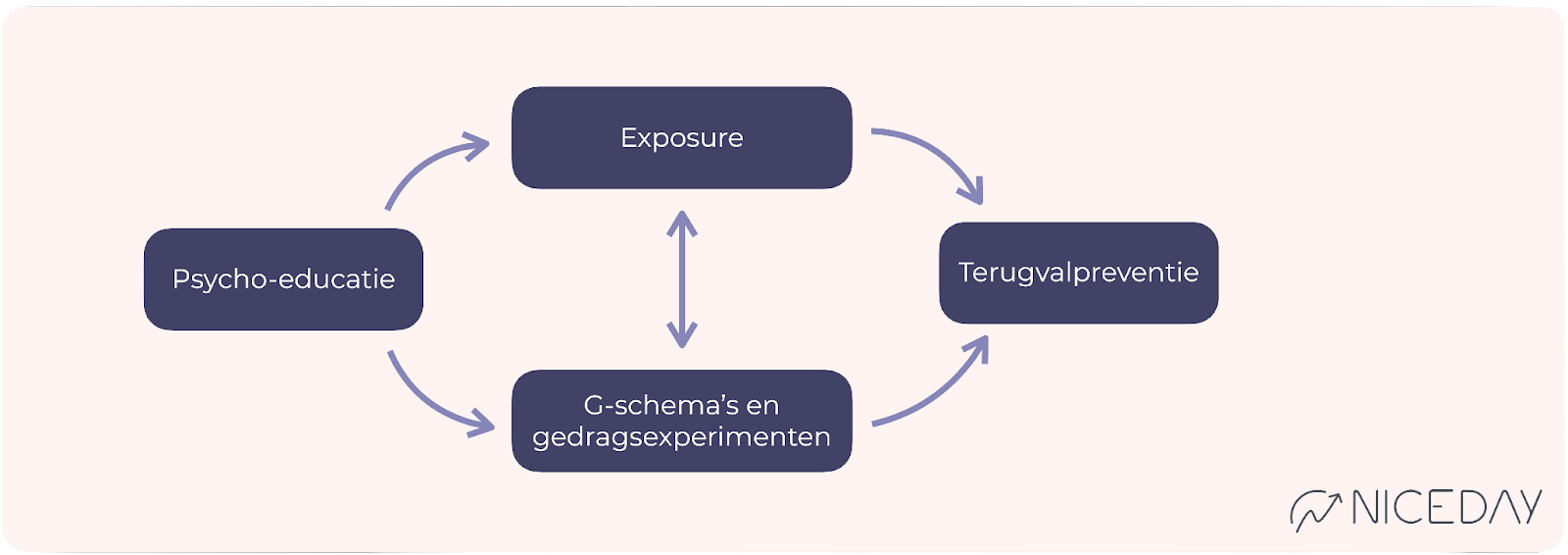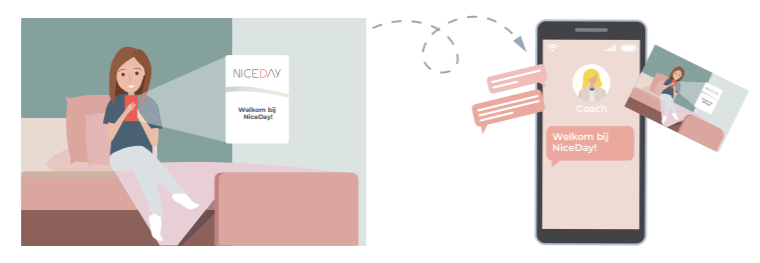Social anxiety Protocol
This protocol for social anxiety is structured around core interventions. It can be implemented both online and in a blended format and is based on existing protocols, scientific sources, and mental health care standards, utilizing the NiceDay platform. Within this treatment, the focus is on emphasizing strengths, building confidence, and promoting an active work attitude. Additionally, it facilitates autonomy through encouragement and motivation, shared decision-making, and involving significant others. Depending on the client's personal situation and symptoms, supportive articles can be used, and sources of inspiration are provided at the end of the protocol.
This protocol provides therapists with guidance and inspiration regarding the various possibilities within NiceDay. It is composed of core interventions that can be employed based on the therapist's assessment. The protocol does not need to be strictly followed, but rather adapted to align with the client's specific situation and symptoms.
Core interventions
The CBT treatment for social anxiety consists of the following core interventions:
🔥 Exposure
🧪 Thought records and behavioural experiments
🧘 Other interventions in social anxiety
- Mindfulness or attention training can be utilized if the therapist and client see added value in it, even though there is no clear evidence for the effects of these interventions as an additional supplement to CBT.
- Social skills training can be employed when there is a clear lack of social skills. Task concentration training and/or role-playing can be practiced.
- Imagery rescripting can be used when there are negative intrusive images related to anxiety (e.g., a memory of a bullying experience).
- Pharmacological therapy can be considered in consultation with the client.
The sequence
The treatment begins with psychoeducation about social anxiety and CBT. When avoidance is a central issue, the next step may involve working on in vivo exposure. If dysfunctional cognitions are prominent, cognitive therapy (using cognitive restructuring and behavioural experiments) can be initiated. The treatment concludes with relapse prevention strategies.
The pace and frequency
Depending on the severity of the symptoms and the effectiveness of the therapy, the duration of treatment can be expected to be approximately 10 to 15 sessions. It is recommended to schedule frequent sessions at the beginning of the treatment. It is important, for the purpose of managing expectations, to discuss and establish the duration of the treatment with your client.
Outcome feedback (OMQ and SMQ)
To monitor progress effectively, you can use two short (5-item) questionnaires that are administered before and after each session. Prior to the session, the Outcome Measurement Questionnaire (OMQ) assesses the severity of the symptoms. After each session, the Session Measurement Questionnaire (SMQ) is administered to evaluate the quality of the therapy session and the therapeutic relationship. You can find the manual for these questionnaires here. If necessary, you can discuss the results with your client.
Flexible time
Flexible time refers to the time you spend on your client outside of the therapy sessions, such as chatting, sending psycho-education materials, or writing session notes. It allows you to stay engaged with your client and monitor their progress effectively. The amount of time needed per client may vary, and you can assess and determine it accordingly. If you're looking for more inspiration on what you can do during flexible time, you can check out this article.
Within the flexibele tijd, there are several standard actions per session:
|
Involving social network
Discuss with your client whether and how the social network can be involved. The environment can both facilitate and unintentionally hinder the treatment process by perpetuating avoidance and safety behaviours. You can find information on how to involve the social network here.
📖 Core Intervention Psychoeducation
The goal of Psycho-education is to provide your client with information about social anxiety and prepare them for one of the core interventions by initiating symptom monitoring. This typically takes about 1-2 sessions on average.
Deepening core intervention psycho-education
Flexible time - prior to the first session: 5 minutes. Welcome message
Sharing Psychoeducation
|
Session (1 or 2 sessions): 35 min
What can you do?
- Explain outcome feedback (OMQ and SMQ)
- Discuss psychoeducation and check for any questions.
- Discuss the treatment goals with the client.
- Explore the possibility of involving the client's social network in the treatment.
- Collaboratively establish SMART treatment goals and establish crisis plans if necessary.
- Complete the model of social anxiety based on the client's symptoms. This model will serve as a framework for the interventions.
- Use a virtual whiteboard tool like Excalidraw and screen sharing.
- Based on the model of social anxiety, activate trackers for symptom monitoring,
such as Anxiety, Safety behaviour, and Avoidance.
Explain the purpose of these trackers and make agreements with the client. - Schedule the next session(s) and activate the OMQ and SMQ.
- Examples of exercises and assignments for home practice:
- Ask the client to create a session note and explain how to do it.
- Encourage the client to read the provided psychoeducation material if they haven't done so already.
- Share psychoeducation about anxiety with the client's significant others.
- Complete the model of social anxiety.
- Fill out the activated trackers as discussed during the session.
- Create a list of safety behaviours or avoidance and ask the client's partner to identify any they recognize. Describe challenging social situations.
- Ask the client to complete the SMQ after the session.
Flexibele tijd: 15 min How can you utilize this time throughout the week?
|
🔥 Core Intervention Exposure
The goal of Exposure is to expose your client to anxiety-provoking situations. Together, you identify the situations that are being avoided, and then repeatedly practice engaging with these situations. This typically takes a minimum of 4 sessions on average.
Deepening core intervention exposure
Flexibele tijd - before the first exposure session: 5 minutes
|
Session 1: 35 mins
- Review the homework together and evaluate avoidance and safety behaviours based on the model of social anxiety.
- Explain Exposure. Together with your client, make an inventory of which situations and activities are avoided or tolerated with high tension.
- Choose a anxiety-provoking situation to practice exposure with your client. It can be challenging but manageable.
- Plan the exposure exercise together using NiceDay and inquire about the anxious "if-then" expectations.
- Examples of exercises and assignments for home practice:
- Perform the agreed-upon exposure exercise.
- Make a list of anxious situations in the diary.
- Continue to track anxiety, avoidance, and safety behaviours.
Flexible time: 20 min
|
Session 2: 35 min
- Go over the home exercises and discuss the exposure exercise.
- Review the list of anxiety-provoking situations together and agree that the client will engage in a daily exposure exercise from the list in the upcoming week.
- Plan which exercise will be done when, either by setting a schedule or allowing the client to plan it themselves.
- Continue discussing the results of all activated trackers.
- Discuss the exercises and assignments for home:
- Schedule and carry out the agreed-upon exposure exercises and record how they went.
- Continue filling out the activated trackers.
Flexible time: 20 min
|
Session 3 to last exposure session: 35 min
- Discuss the exposure exercises.
- Monitor together if the treatment goals are being achieved.
- Continue with daily practice of exposure exercises, letting the client plan them in NiceDay.
- Plan which exercises will be done when, either by yourself or let the client plan them.
- Exercises and assignments for home:
- Schedule the agreed-upon exposure exercises, carry them out, and record how they went.
- Ask your client to create a session note for this session.
- Continue filling out the activated trackers.
Flexible time: 20 min
|
Evaluate the effectiveness of the exposure exercises and insights gained after 5 sessions. If the exposure is effective, continue until the anxious expectations are disproven and the treatment goals are (largely) achieved. If you notice that the therapy is not having sufficient effect, despite the efforts of both the client and yourself, discuss this with the client and in the multidisciplinary team meeting (MDO). Explore possible causes and, if necessary, adjust the therapy. You can then begin cognitive restructuring using thought records and behaviour experiments.
🧪 Core Intervention Thought records and Behavioural Experiments
The goal of Thought Records and Behavioural Experiments is to examine and test the impact of unhelpful thoughts on unwanted emotions or behaviours, and evaluate them based on reality. You identify and challenge unhelpful thoughts using Thought Records, and design behavioural experiments to practice new behaviours. On average, this process takes at least 6 sessions.
Deepening core intervention thought record
Deepening core intervention behavioural experiment
Flexible time - before the session: 5 min
|
Session 1: 35 mins
- Check if there are any questions about the shared psychoeducation.
- Explain the influence of anxious cognitions using the example of Coach A and Coach B.
- Explore with Socratic method what the anxious cognitions regarding social situations are.
- Together, fill in step 1 of the Thought record in NiceDay based on this information. Check if the Thought record is clear.
- Examples of exercises and assignments for home:
- Fill in step 1 of a thought record for anxiety-provoking situations.
- Ask your client to make a session note of this session.
- Encourage your client to continue tracking anxiety, avoidance, and safety behaviours.
Flexible time: 20 min
|
Session 2: 35 min
- Discuss the exercises and assignments that were done at home and evaluate step 1 of the thought record together with the client.
- Introduce steps 2 and 3 of the thought record by providing psychoeducation on challenging thoughts within a thought record. Then, together, you can challenge a thought using a previously completed thought record.
- If necessary, discuss psychoeducation on thinking styles.
- Examples of exercises and assignments for home:
- Complete steps 1 to 3 of the thought record for anxious situations.
- Ask your client to set a daily reminder for the thought record to remind them to fill it out.
- Encourage your client to continue registering their anxiety, avoidance, and safety behaviours.
Flexible time: 20 min
|
Session 3: 35 min
- Discuss the homework exercises and encourage your client to continue filling in the thought record.
- Discuss the helpful thoughts and insights gained. Use this as a bridge to introduce behavioural experiments.
- Review the overview of avoidance and safety behaviours in the graphs in NiceDay to discuss the effect of the interventions. Additionally, the OMQ can provide visual representation of progress.
- Provide an explanation of behavioural experiments.
- Explain why it is important to start experimenting with different behaviours. Ask your client what someone else would do if they were guided by these new helpful thoughts.
- You can also consider using the recorded safety behaviours and/or avoidance as inspiration for behavioural experiments.
- Together, develop the first behavioural experiment and schedule it in NiceDay. Both you and your client have the ability to schedule it.
- Examples of exercises and assignments for home:
- Continue practicing steps 1 to 3 of the thought record.
- Conduct the behavioural experiment and record it in NiceDay.
- Continue tracking anxiety, avoidance, and safety behaviours.
Flexible time: 20 min
|
Session 4 to completion: 35 min
- Discuss how the first behavioural experiment went.
- Encourage your client to continue filling out the thought records.
- Together, come up with more experiments for your client to practice (ideally as many as possible). You can find examples of behavioural experiments and guidelines on how to create them in the Knowledge Base.
- Examples of exercises and assignments for home:
- Continue filling out thought records.
- Perform the behavioural experiments and record them in NiceDay.
- Continue recording levels of anxiety, avoidance, and safety behaviours.
Flexible time: 20 min
|
Evaluate the effectiveness of the thought records and behavioural experiments, as well as the insights gained, after 5 sessions. If the intervention is effective, continue until the new cognitions and behaviours are more or less integrated and the treatment goals are (largely) achieved. If you notice that the therapy, despite the efforts of both you and the client, is not having sufficient effect, discuss this with the client and in the multidisciplinary team (MDT) meeting. Investigate possible causes and adjust the therapy if necessary.
🔁 Core intervention Relapse prevention
The goal of Relapse Prevention is to map out how someone can recognize and monitor potential relapse, identify their pitfalls, and provide them with tools to deal with symptoms or situations. This typically takes about 1-2 sessions.
Deepening core intervention relapse prevention
Flexible time - before the first relapse prevention session: 5 min
|
Session (1 or 2 sessions) 35 min
- Reflect on the progress of the OMQ and SMQ and discuss any other (ROM) questionnaires.
- Evaluate the treatment:
- Discuss the effect of the treatment.
- Identify obstacles that have been overcome and those that are still present.
- Predict and normalize: it is normal to experience anxiety again in the future. Stress, fatigue, and/or changes in one's life can play a role in this.
- Create the relapse prevention plan together:
- Create a list of situations and problems where relapse into "old behaviours" is a risk.
- Have your client write down a strategy for each situation that can be applied in these specific situations.
- Exercises and assignments for home:
- Encourage your client to continue applying everything they have learned. This includes using the app, such as filling out trackers to remain alert to the amount of avoidance and safety behaviours, and using the thought record to challenge unhelpful thoughts.
- Ask your client to complete the relapse prevention plan.
Flexible time: 20 min
|
📚 Use blog articles
Depending on your client's personal situation and symptoms, you may choose to send supportive blog articles. These articles are written by professionals and individuals with lived experience, and can be found on niceday.app. Some topics to consider include:
- Mind Reading: Can We Do It?
- Dealing with negativity
- Learn to relax
- Worry about what others think of you
- Goodbye social anxiety
- Doom thinking
- Tips: adjust rules of life
- Affirmations against your anxious thoughts
- Did you know that your behaviour always has a function
- Four tips for a better self-image
- Do I have a realistic self image?
- Doom thinking
- Avoidance: short-term relief for your long-term problems
Sources
- https://www.ggzstandaarden.nl/zorgstandaarden/angstklachten-en-angststoornissen/individueel-zorgplan-en-behandeling/behandeling-en-begeleiding/psychologische-en-psychotherapeutische-behandeling
- Voncken, M., & Allart, E., Protocollaire behandeling van patiënten met een sociale-angststoornis. In: Keijsers, G. P. J., Van Minnen, A., Verbraak, M., Hoogduin, C. A. L. & Emmelkamp, P., (2021). Protocollaire behandelingen voor volwassenen met psychische klachten.
- Mayo-Wilson, E., Dias, S., Mavranezouli, I., Kew, K., Clark, D. M., Ades, A. E., & Pilling, S. (2014). Psychological and pharmacological interventions for social anxiety disorder in adults: a systematic review and network meta-analysis. The lancet. Psychiatry, 1(5), 368–376.
- https://www.tijdschriftgedragstherapie.nl/inhoud/tijdschrift_artikel/TG-2014-4-3/Sociale-angst-en-aandacht



